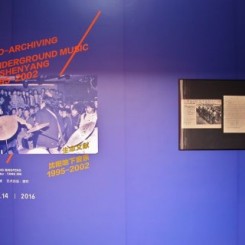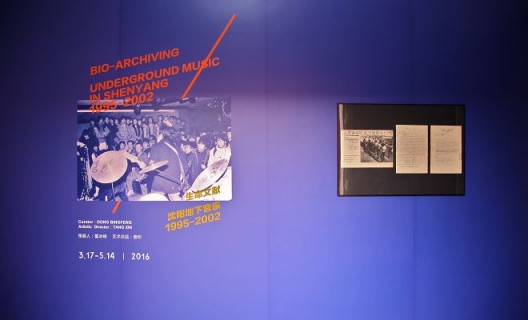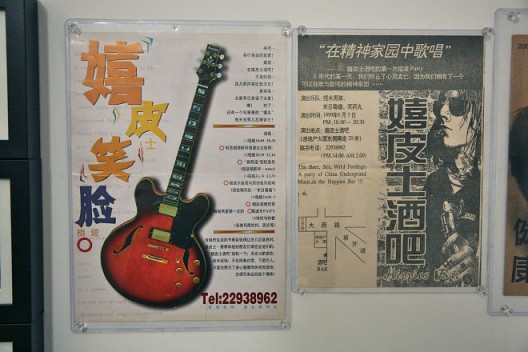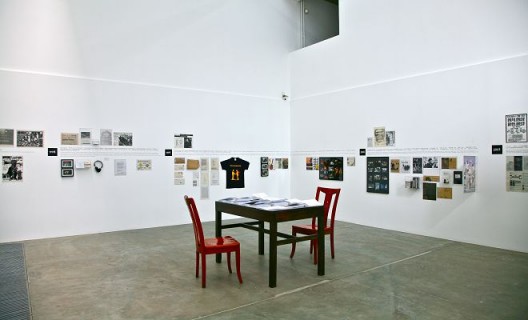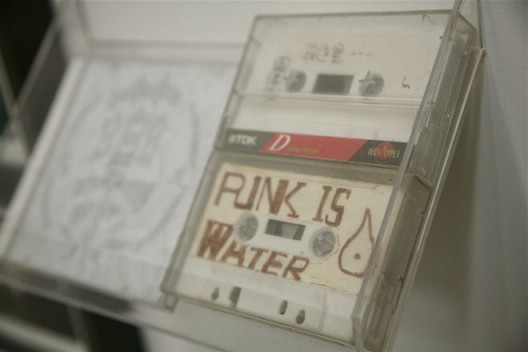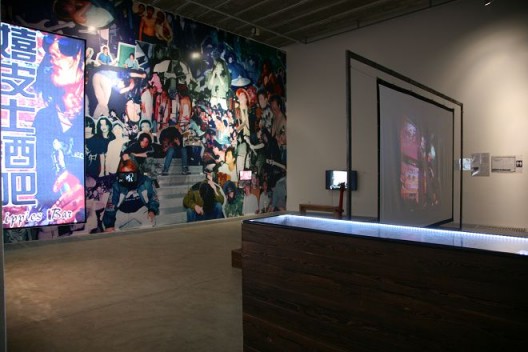“Bio-archiving: Underground Music in Shenyang 1995-2002″
Taikang Space (B2 Red No.1-B2, Caochangdi, Cuigezhuang,Chaoyang District, Beijing), Mar 17 – May 14, 2016
This is an exhibition that hesitates to speak. When I say that, I refer not only to the way in which it expresses itself, but also the way it is being talked about. One version of the story of this exhibition is as follows: twenty years ago, when curator Dong Bingfeng was at school in Shenyang, he was a participant in the city’s nascent underground music and art scenes and an important organizer in the community. Twenty years later, the opportunity has come to convert analog to digital, to collect and arrange the history of Shenyang, and to make a retrospective exhibition featuring the people, events, and works of art of those years before they are buried and forgotten forever. The organizers believe that, it being twenty years after the fact, this moment in history would truly disappear if not for an exhibition, and if not now, the need for it to be exhibited at all will have passed. Twenty years ago, A Bai, born in 1976 and a core member of the band Jiaoshui Boys, along with Xiao Han, another core member born in 1974 who ultimately died of cancer, were in the most vibrant periods of their lives, fueling their rock music with their own incandescent life forces. Thus, curator Dong Bingfeng, a party to this moment in history, calls the exhibition a “Bio-archive.” The name is perfectly appropriate, as the exhibition is a record of that life force within its historical context, and a rebellion against time itself.
But this version of the story alone would be a bit too much like the sentimental plot of a novel or film. If the exhibition were to remain at this level, or to over-emphasize this direction, it could not possibly be received in the field of contemporary art, nor would it bear much significance for any other viewers—even for those who are indifferent to the critical efficacy of an exhibition. The layout of this exhibition therefore attempts to resist this sort of pure nostalgia so as not to overwhelm with it. A lot of consideration of this has gone into every level of the show, which is one reason that it “hesitates to speak.”
The question we must ask, however, is: why, in this moment, is it worthwhile to exhibit Shenyang’s underground nineties music scene in an art space in Beijing, especially since “coming to Beijing” has always implied an added level of recognition, and not only in the art world? To answer this question, we must lend it a common discourse for comparison. Specifically, are we looking at this because it is a universal example of an underground culture in a second or third-tier city in China in the nineties, or because it is or was one-of-a-kind in its irreducible wildness? Is it because this culture was representative of an avant-garde ideology, or because of its grass-roots status in a working class city? Was this moment the first early sprouting of a culture’s commercialization, or was it a carnival in the final days of the disintegration of socialist industry? Today it would be unimaginable to see rock music performed at venues like Shenyang’s Mining Cultural Center, the sporting field of Lu Xun Academy of Fine Arts, or Lei Feng Stadium. Were these moments possible thanks to powerful movements of self-organization? Were they remnants of socialist collective culture, or were they filling a vacuum at large industry’s end of days? Was it because leisure activity in the city was not yet diversified, and so rock-n-roll grabbed an opportunity? If this is about universality, in which sense is it universal? If this is special, in what sense is it both special and also possessing of “common” value? This is an exhibition that touches upon all of these possibilities, but does not emphasize a single one, likely because it fears that by emphasizing one aspect or stance, it will suppress others. Indeed, how can one exhibition make any one assertion about a period of history? Is the curator deliberately trying to avoid doing this? Or attempting to neutralize all of these historical documents by including all of their varied, rich detail? Is this a reflection of the curator’s comprehension of the complex causes and effects behind this piece of history? At the exhibition entrance, we see a piece of text written by Ma Zhongren before his show at the Mining Cultural Center. It is a rare burst of emotion, a kind of call-to-arms seldom seen in today’s rock circles. It seems influenced by a radical, ideologically complex discourse not yet exposed to the language of technology. Perhaps these words, paired together with the exhibition’s official poster, embody the curator’s intentions?
But there is another problem that has yet to be solved: where does criticism come into play? Does the contemporary art world do what it does, and treat each piece shown here as an art work on its own? Or are these only historical documents? If this were an exhibition containing only historical documents, there would be no cause for art criticism. But what if we are looking at works of music, film, or literature—for instance Ma Zhongren’s polemic writings, the songs of the Jiaoshui Boys at the time, A Bai’s essays, Dong Bingfeng’s Rehearsal, the song Youth Monument, which to this day is sung among young people in Shenyang? If we are only able to see these pieces of art as archival materials, and not as art works in their own right, is it because today’s art-critical language has already evolved past the point of having a way to address this kind of work, or because critical discourse itself has no way to engage with works whose underlying ideologies or practices are unclear? If the latter is the case, communication of any kind would be the same as not trying at all, because critical discourse itself does not handle these issues, and could therefore only speak to itself, within the confines of its own systems, thus resulting in more hesitation to speak out of not having anything to say on the subjects themselves. This leaves only a simpler, broader discussion on the overall state of nineties underground music culture to be had, with the reasoning that it is better to talk generally about the forgotten narratives of history than to engage in the specifics of these forgotten narratives. In addition, though the antithesis of rock-n-roll music has already materialized—to the point where even Song Yuzhe, who abandoned rock in the early years and devoted himself to experimental music for so many years, has returned to rock and gotten his group “Wood Pushing Melon” back together—art criticism has not made any departure from isolated engagement with the specific music and texts in this exhibition. Criticism here is thereby reduced to platitudes: things already known that can be repeated without amendment. This makes it impossible to make any kind of historical or artistic evaluation of the criticism itself.
Perhaps the ultimate significance of these archives will always come back to what Svetlana Boym refers to as “Reflective Nostalgia”: how the distance of a particular time and space can never be recovered, but what can be recovered is that sense of the original state of something, that last flash of light before its death. As such, the only way to re-activate these details—each specific event within each city’s underground music culture, including that of Shenyang, these pieces of life crystallized within the “bio-archives”—and bring them new life would be to connect them to the critical thought and experiences of self-organization in our reality today. This work is not finished with this exhibition. It has only just begun. And it can only continue with a return to its original place.
